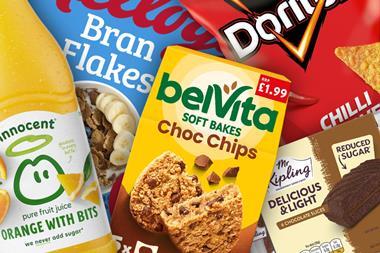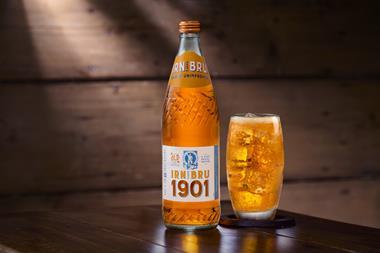Coca-Cola is the most powerful brand in the UK this year but its dominance is under threat as brands playing on their health and convenience credentials move up the pecking order.
Valued at more than £1bn, Coke is more than twice as valuable as any other brand, according to a unique table of the UK's most valuable grocery brands compiled for The Grocer by independent brand valuation consultancy Intangible Business. Its prospects are looking precarious, however, as consumers switch to healthier, non-carbonated drinks and it is accused of lack of innovation and poor corporate social responsibility.
Brands perceived to be healthy or convenient, on the other hand, such as Actimel, Young's frozen fish, Uncle Ben's Rice, Kellogg's Special K and Tropicana, are rising rapidly.
The table is the first to value brands using soft measures such as brand awareness and relevance as well as the usual hard financial measures. It provides retailers, brand owners and investors with a unique insight into which brands are the most valuable, which consumers identify with most, which are growing and which are in decline. It also gives an early indication of what The Grocer's annual Top Products Survey in December may reveal.
The picture that emerges couldn't be clearer: brands ignore the health agenda at their peril. Sales of Coke have already declined 2% year-on-year since 2003 and could be hit harder still as restrictions on advertising to children kick in.
Actimel, however, though only 18th in the table with a £195.5m value, is the fastest-growing brand in the top 100, having notched up sales growth of 48% a year since 2003, despite mounting competition from Müller, Ski, Yeo Valley, Benecol and Yoplait. It has benefited from growing consumer interest in probiotic drinks as well as from the strength of its parent company Danone. Despite the frozen category's well-documented woes, Young's has also grown significantly under the stewardship of private equity firm CapVest. The brand's sales have grown 28% a year since 2003 thanks to a more positive consumer perception of frozen food, Young's proactive stance on NPD and lack of competition from Birds Eye.
Sales of Uncle Ben's rice have shot up 19% a year, taking its brand value to £83.3m, buoyed largely by lack of a significant branded competitor.
There has been a resurgence in other brands such as Kellogg's Special K, thanks to the healthy-eating trend. It commands a 50% price premium on own-label equivalents, yet it too has seen sales increase, by 18% a year - as has PepsiCo's Tropicana, which has successfully added to its core range with new flavours as well as new formats such as 330ml bottles and Tropicana Go!
However, Coca-Cola is not the only brand that is in a spot of trouble. Fanta, also owned by The Coca-Cola Company, has also been hit by the general malaise affecting the carbonated soft drinks sector and is coming under fire from non-carbonated drinks such as Robinsons' Fruit Shoot and premium adult soft drinks such as Shloer.
As a result, it was the worst performer in the table, having lost 13% of sales a year since 2003 - a trend that is accelerating.
Despite product extensions and lucrative tie-ups with Disney, Kleenex is another brand not doing as well as might be expected, according to the report. Sales have fallen 8% a year since 2003.
The old market leaders in the household and personal care market, Comfort and Persil, have also struggled, with sales down 8% and 7% respectively. And having one brand that is doing well provides no immunity to failure. Sales of Kellogg's Corn Flakes, unlike Special K, have fallen by 7% a year.
Stuart Whitwell, joint MD of Intangible Business, says: "The ones doing well are the ones with a health agenda. Actimel is 18th by brand value yet only 48th by turnover. Weetabix is the number one dry staple once again, building on its health heritage. Heinz has also come out strongly."
Walkers has kept its head above water by making a strong play of its reformulated product range.
Some are doing well despite the health agenda, trading on strong intrinsic brand values. Not even a salmonella scare could hit Cadbury Dairy Milk, the £524m brand that is second in the overall table.
"With such a strong heritage, the brand is deeply embedded in our culture and is difficult to dislodge," says Whitwell.
Perceived heritage and provenance have also played a part in the success of a number of brands. Whitwell singles out Magners, Cathedral City Cheddar, Richmond sausages and Ginsters.
For others, the key has been a strong track record in NPD. He highlights the strong performance of Warburtons, whose chairman Jonathan Warburton has been nominated for this year's The Grocer Cup. "It's come out of nowhere," says Whitwell of its sudden upwards trajectory. Based on bolstered distribution and strong new product development, growth is set to continue following its decision to double production at Enfield by January, taking it from 80% to near nationwide penetration.
Where Warburtons has helped its cause by developing new products such as the Toastie, others in bread have not fared as well. "Kingsmill as a brand is performing worse than it should do, maybe because it's competing at a less premium level than Warburtons, but it hasn't got the same resources or presence."
William Grobel, marketing director at Intangible Business, also highlights the contrasting fortunes of Kellogg's Corn Flakes and other growing cereal brands. He says: "Corn Flakes is a bland brand - it hasn't extended into other areas, whereas Weetabix, for instance, has Weetabix Gold and Minis."
Coca-Cola, too, has made the mistake of relying too heavily on variations on the same theme rather than genuine diversification, he says. "Coca-Cola has two brands in the top 100, but its focus is all on one, whereas PepsiCo has six. We think PepsiCo's strategy is far better than Coca-Cola's because it's diversified. Not long ago, PepsiCo's market capitalisation beat Coke's for the first time."
KitKat has experienced similar problems but like Coke remains one of the strongest brands in its category despite a decline in sales.
With other brands that are beginning to struggle, it is not so much a matter of lack of diversification as lack of focus, says Whitwell, highlighting personal and household care. "How poorly Persil is doing shocked me. It doesn't seem to be getting the attention from Unilever that it once did.
"Andrex caught my eye because of how valuable it is, however, and how far ahead of the competition."
In terms of categories, despite the problems on the carbonated front, soft drinks are still the place to be. At £3.2bn, it's worth almost double the confectionery market and more than three times bakery. It accounts for a quarter of the total value of the top 100. Biscuits and snacks, however, languish in 10th place with a total brand value of £617.8m.
Over the next year, health, wellbeing and premium are expected to be the key drivers as consumers take their credit and debit attitude towards diet to the next level. Provenance, too, will play an increasingly important role.
Whitwell says: "Will the strongest-performing brands keep it up? Actimel is at the top in terms of growth: is it going to hit a buffer?" Grobel adds: "Will there be a battle between Warburtons and Hovis?"
As for which brand will reign supreme in 2007, it would be a brave man who bet against Coke, which is almost twice the value of the second brand in this year's table - but it will have to pull its finger out if it is to regain its fizz.n
Methodology
The brand value is a reflection of a brand's ability to generate future income. The study uses historic performance and future trends to predict future activity. Three years of historical data have been provided by ACNielsen for each brand, based on sales data from more than 83,000 grocery stores. To determine the strength of the brands, each was scored on nine measures of brand strength provided by quantitative consumer data and qualitative panel data. The hard measures were: share of market (volume-based measure of market share); brand growth (projected growth based on three years' historical data and future trends); price positioning (a measure of a brand's ability to command a premium); market scope (number of markets in which the brand has a significant presence).
Soft measures were: brand preference (a measure of relative pre-disposition or spontaneous selection of a brand); brand awareness (a combination of prompted and spontaneous awareness); brand relevance (capacity to relate to the brand and propensity to purchase); brand heritage (a brand's longevity and a measure of how it is embedded in local culture); brand perception (loyalty and how close a strong brand image is to a desire for ownership).
For more information, contact William Grobel at Intangible Business.
Tel: 0870 240 7386 E-mail: william.grobel@intangiblebusiness.com.
Web: www.intangiblebusiness.com


















No comments yet